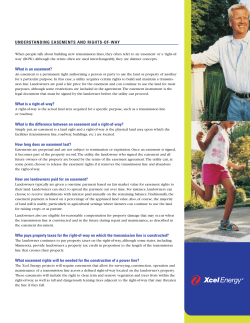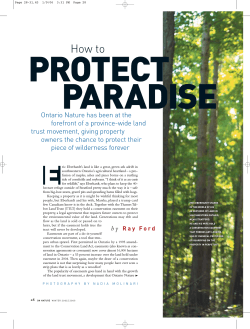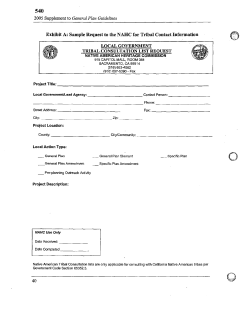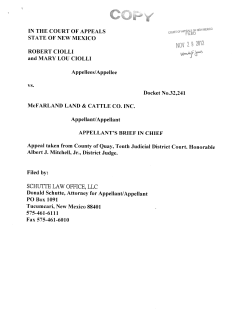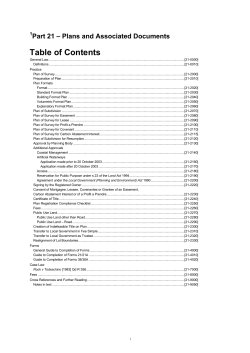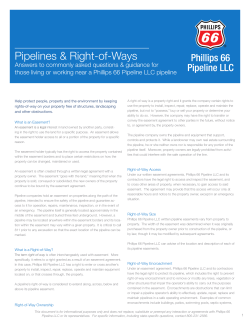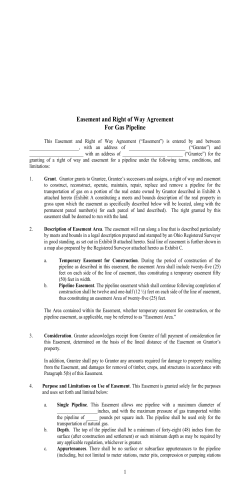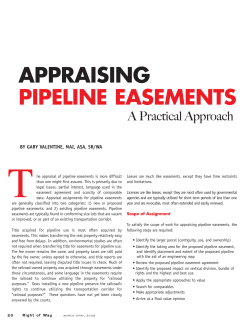
Procedures Manual
Procedure # Land Titles Subject: Procedures Manual EASEMENT / ENCROACHMENT / PARTY WALL AGREEMENT Page EAS-1 1 of 6 Date Issued 2002 01 01 BACKGROUND An easement confers on the owner of a parcel of land "the right to use the land of another in some way, or to prevent it from being used for certain purposes." (1) It is: "A right in the owner of one parcel of land, by reason of such ownership, to use the land of another for a special purpose not inconsistent with a general property in the owner." (2) The common law requires four conditions to be satisfied in order to create an easement which is enforceable by and against successors in title to land. (3) 1. There must be a dominant tenement and a servient tenement which may be defined as follows: a) dominant tenement, a parcel of land "for the benefit or advantage of which an easement exists or is enjoyed." b) servient tenement, a parcel of land "which is subject to the burden of an easement existing for or enjoyed by another tenement." An easement cannot exist in gross (i.e., without a dominant tenement). (4) 2. The easement must accommodate the dominant tenement in the sense of making the dominant tenement a better and more convenient property. 3. At common law the dominant and servient tenements could not be both owned and occupied by the same person. However, section 68 of the Land Titles Act has changed this condition in Alberta law. It provides that an owner may grant an easement to himself for the benefit of land which he owns and against land which he owns. Consequently, when dominant and servient tenements become registered in the name of the same person, an easement does not necessarily merge by reason of common ownership. 4. The easement must be capable of forming the subject matter of a grant. In general terms, this condition means that the right granted in the easement must be within the general nature of rights which the law has recognized as easements. In most jurisdictions, an easement can be created by express grant, by statute, by implication of law or by prescription. (5) Statutory easements are created by different Alberta Acts (e.g., the Irrigation Districts Act) and are registered as orders or certificates but have the same effect as an easement. Section 69 of the Land Titles Act authorizes the registration of certain utility rights of way which do not require a dominant tenement. Where an owner conveys part of a parcel of land, the common law will imply such easements as are necessary to the reasonable enjoyment of the property conveyed, such as a way of necessity to give access to a land-locked parcel. Prescription (the acquisition of rights through long-continued enjoyment of the rights) is not applicable in Date Issued 2002 01 01 Page 2 of 6 Procedure # EAS-1 Alberta by virtue of section 69(3) of the Law of Property Act, R.S.A. 2000, c. L-7 which states that no easement may be acquired by prescription. The land mentioned in any certificate of title granted under the Land Titles Act is by implication and without any special mention therein subject to a) any public highway or right of way or other public easement, howsoever created, on, over or in respect to the land, and b) any right of way or other easement granted or acquired under any Act or law in force in Alberta. (6) REGISTRATION PROCEDURE 1. There must be a dominant and servient tenement clearly specified in the document presented for registration. One or both of the tenements may be a leasehold estate. The dominant and servient tenement need not be contiguous. (7) An owner cannot grant himself an easement where one parcel of property purports to be both the dominant and servient tenements. 2. There must be a certificate of title issued for both parcels of land. If the servient tenement is a leasehold interest, a certificate of title must be issued for the leasehold interest. If the dominant tenement is a leasehold estate, a certificate of title must be issued for either the fee simple estate or the leasehold estate. (8) If title has been issued for only one of the parcels, the easement may be registered by way of caveat. (9) 3. The registered owners must be the same as the grantor and grantee of the easement and they can be the same person. (10) 4. Legal Description Requirements a) The legal descriptions of both tenements must be consistent with the land descriptions in the existing certificates of title. b) An easement affecting the whole servient tenement (i.e., a blanket easement) may be registered. b.1) An easement affecting existing improvements like utilities, access road etc. may be registered as a blanket easement provided it does not refer to any sketch or reveal the location. c) Where the portion of the servient tenement affected by the easement is described by reference to a registered plan, the plan must be checked to ensure that it affects the land in the title. d) Where a metes and bounds description is used to describe the portion affected by the easement, the document must be referred to the Surveys section for description approval. A sketch illustrating the metes and bounds description may be attached but a sketch cannot be accepted on its own to describe the portion of the parcel affected. Date Issued 5. 2002 01 01 Page 3 of 6 Procedure # EAS-1 Acceptable Easements The following is a list of some recognized easements. As this list is not exhaustive, any doubtful easement documents should be referred to a supervisor. a) right of way for passage by pedestrians or vehicles b) right of access c) right to park vehicles d) right of drainage e) right to project eaves and gutterings over a property boundary f) right of light g) right to support h) right to maintain and service utilities (usually between owners of duplexes) i) right to commit a nuisance (11) 6. The easement must be signed by the owner of the servient tenement. Some mutual easements, such as joint driveway agreements, confer rights and obligations on both parties so that each tenement is both servient and dominant and the document must therefore be signed by both parties. 7. Attestation requirements must be complied with (see procedures under AFF-1, AFF-2 and COR-1). 8. Dower requirements must be complied with (see procedure under DOW-1). 9. a) An easement is endorsed against title as follows: servient tenement (Lot 14): "EASEMENT FOR BENEFIT OF LOT 15" dominant tenement (Lot 15): "EASEMENT OVER LOT 14" mutual easement (e.g., joint driveway agreements): "EASEMENT RE JOINT DRIVEWAY OVER LOTS 14 AND 15". b) c) If one of the tenements is a leasehold estate, the particulars should include the following: "BENEFITTING THE LEASEHOLD ESTATE" or "BURDENING THE LEASEHOLD ESTATE". as the case may be. 10. Party Wall Agreements - The registered owners of adjoining parcels of land may enter into a party wall agreement: a) declaring certain existing walls or walls that are to be constructed on those parcels to be party walls, and b) setting forth the rights, privileges, easements and covenants that exist in respect of the party walls. Date Issued 2002 01 01 Page 4 of 6 Procedure # EAS-1 A person who is the registered owner of adjoining parcels of land may register a declaration of the above. The rights, privileges, easements and covenants under the party wall agreement are deemed to run with the land. (12) In order to be registered, the agreement or declaration must comply with attestation and dower requirements. The endorsement on the titles is as follows: "PARTY WALL AGREEMENT RE LOTS 14 AND 15". 11. Encroachment Agreements - Although an easement cannot grant exclusive or unrestricted use to the dominant tenement, (13) the Land Titles Act permits the registration of an encroachment agreement executed by the owner of a parcel of land (the servient tenement) to permit the encroachment of an improvement made on an adjoining parcel of land (the dominant tenement). Certificates of Title must exist for all parcels of land affected by the agreement. (14) A real property report prepared by an Alberta Land Surveyor showing the encroachment must accompany the document. It is registered against both parcels in the same manner as an easement. For example: a) servient tenement (LOT 14): "ENCROACHMENT AGREEMENT FOR BENEFIT OF LOT 15" b) dominant tenement (LOT 15): "ENCROACHMENT AGREEMENT OVER LOT 14" Attestation and dower requirements must be complied with. Once the agreement is registered, it runs with the land to the same extent as if it was an easement. (15) A caveat may be registered by a municipality pursuant to the Municipal Government Act when the encroachment is over a road (see procedure under CAV-5). Where the encroachment is over a utility right of way or easement, the existing legislated provisions of the Land Titles Act already provide for the registration of an amending agreement (or a caveat re: amending agreement) which amends the terms of the utility right of way to allow for the existence of the encroachment. A caveat submitted by the owner of the dominant tenement may also be accepted for registration. No party information is shown. 12. Discharge of Easements, Party Wall Agreements or Encroachment Agreements - A discharge in the prescribed form (FORM 10.1), executed by the registered owner of the dominant tenement, is required. (16) For mutual easements such as joint driveway agreements and for party wall agreements, as both parcels are dominant tenements, the registered owners of both parcels must execute the discharge. In all cases, the original instrument must be checked to verify the dominant tenement(s). Attestation requirements must be complied with. 13. Expiry of Easements, Party Wall Agreements or Encroachment Agreements - An owner of land affected by an easement, a party wall agreement or an encroachment agreement may request in writing that the Registrar cancel the registration of the instrument where the interest created by the instrument has expired. The Registrar must be satisfied that the interest has expired through an express provision in the instrument. This requirement may be met by a provision which states Date Issued 2002 01 01 Page 5 of 6 Procedure # EAS-1 that the interest will expire on a specific date or following a specific period of time after the date of execution of the instrument. (17) Normal attestation requirements do not apply. Document type DISO is used to remove the instrument from the title. 14. Fees - Tariff items 11(6) and 11(5) are charged for all registrations and discharges, including expiries, respectively and extra endorsement fees are charged under Tariff item 13. If a description approval is required, Tariff item 9 is also charged. STATUTE AND CASE REFERENCES Statute references are to the Land Titles Act, R.S.A. 2000, c. L-4, unless otherwise indicated. 1. 2. 3. 4. 5. 6. 7. 8. 9. 10. 11. 12. 13. 14. R.E. Megarry and H.W.R. Wade, The Law of Real Property, (3rd ed. 1966) p. 145 Henry Campbell Black, Black's Law Dictionary, (4th rev. ed. 1968) p. 599 Re Ellenborough Park; Re Davis; Powell Maddison [1956] Ch 131 (Court of Appeal of England) and Principles of Property Law (2d) Ziff (1996) pages 328332 In G.C. Cheshire, Cheshire's Modern Law of Property, 9th ed. at p. 448, "in gross" is explained as follows: "an easement that is independent of the ownership of land by the person who claims the right. Of course a person who does not own a yard of property may be granted a privilege to pass over Whiteacre, but though this may give him a contractual right it certainly does not entitle him to an easement. It amounts to a licence confined in its effect to the actual parties." V. DiCastri, Thom's Canadian Torrens System, 2nd ed., at p. 47 s. 61(1)(c) and (f) and Husky Oil Operations Ltd. and Alberta Inspector of Land Titles v. Shelf Holdings Ltd. (1989) 65 Alta. L.R. (2d) 300 (Alta. C.A.) and PetroCanada Inc. v. Shaganappi Village Shopping Centre Ltd. (1990) 76 Alta. L.R. 162 (Alta. C.A.) Gale on Easements, 14th ed. by Spencer G. Maurice at p. 20 states: "If land to which a right purports to be annexed is in fact accommodated by the use of the right, the right qualifies as an easement whether the dominant and servient tenements are contiguous or not. A right of way, not ending anywhere on the land to which it is annexed, will be a valid easement if the owner of the land owns, or otherwise has the right to pass over, the intervening land." s. 67 Rystephaniuk v. Prosken (1951), 3 W.W.R. (NS) 76 (Man. K.B.) supra, footnote 4 and s. 68 British Columbia Forest Products Ltd. v. Nordal and Nordal (1954), 11 W.W.R. (N.S.) 403 (B.C.S.C.) s. 71 Husky Oil Operations Ltd. and Alberta Inspector of Land Titles v. Shelf Holdings Ltd., supra, footnote 6 s. 72(b) Date Issued 15. 16. 17. s. 72(a) s. 73 s. 73(2) 2002 01 01 Page 6 of 6 Procedure # EAS-1
© Copyright 2026

